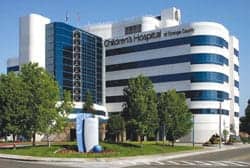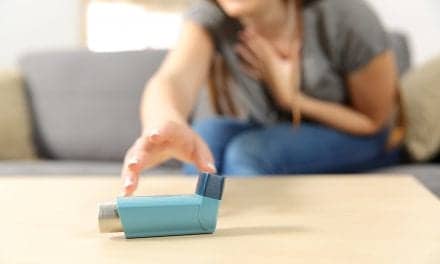A Southern California Children’s Hospital Is a Magnet for RTs Who Want a Career in Pediatric Care
-
- Children’s Hospital of Orange County
By their very nature, children’s hospitals are alert to the health concerns of the pediatric population, but few of them take their mission as personally as Children’s Hospital of Orange County (CHOC), a nonprofit organization dedicated exclusively to pediatric care.
Located in the ethnically diverse suburb of Orange, Calif, CHOC might not have the visibility of its Anaheim neighbor, Disneyland, but the hospital could not ask for a more convenient location for servicing Orange County and surrounding Riverside and San Bernardino counties. “Where we’re located is called the Orange Crush,” says Maila Factora, the hospital’s director of respiratory services. “Because that’s where three freeways—the 22, the 57, and Interstate 5—merge and is one of the busiest interchanges in Orange County.”
But its convenient location and large service area are at the bottom of a long list of reasons that potential RTs might be interested in working at CHOC. For new graduates, the hospital’s respiratory pediatric residency program, which offers 5 months of extensive training, has been the hospital’s number one source of recruitment. The facility also offers a 3-month fast-track residency program for respiratory therapists who have worked with adults but are now interested in specializing in pediatrics.
“This August, 14 new residents will be joining our team for the RCP New Grad Residency Program. The RCP New Grad Program is for those who want to move into the pediatric specialty arena in respiratory care upon graduation from an accredited respiratory program,” Factora says.
Practicing Autonomy
Factora takes pride in the independence her RTs demonstrate in their daily duties at the hospital.
“CHOC RTs are very autonomous. They have built such strong relationships with the physicians, especially in the Critical Care Units, that they are allowed to direct ventilator changes and interventions independently and report progress to the physicians,” says Factora. “In many other facilities the RTs wait for the physicians to initiate all ventilator interventions; that is not the case at CHOC. The RTs are self-directed and proactively discuss clinical interventions with the physicians.”
-
- A respiratory therapist obtains a blood gas sample through the patient’s UAC line.
Take this recent shift log as an example:
“Dr. Hicks denufosol tetrasodium study: This study involves randomization of patients with a diagnosis of mild CF. This medication is a mucolytic. Patients have 10 visits total with 6 phone contacts. During the visits the patient does a PFT, blood and sputum is collected. Information on their health since the last visit is collected and, depending on the visit, the patient then may have a treatment of the study drug (this is after visit #6). I collect all of the data, process the labs, and send [them] to the central lab. I enter all data in the electronic data capture and send to the sponsor. A monitor comes once a month and reviews all of the data with me.”
The internship-like approach extends not only to complex ministrations but also in the way CHOC staffers carry out the daily aspects of the job, even if they are comparatively routine.
“Clinical initiatives, new interventions, or updates in our practice are monitored by our Clinical Practice Team. The team is managed by one of our staff members and not by management staff,” says Factora. “It supports a shared governance model that is not seen in many other respiratory departments.”
Besides being taught to act more like scientists and less like assistants, RTs at CHOC get an exceedingly well-rounded education by participating in a broad range of departments within the hospital—from medical/surgical and critical care to oncology, a pulmonary function laboratory, and a pulmonary clinic. “Multitasking is an integral part of their job,” Factora says. “RT associates in the RT department are cross-trained in all of the different patient care areas.”
Factora adds that because the department is protocol-driven, patient care is a seamless process. “We have asthma and bronchiolitis guidelines as well as ventilator protocols in the NICU and PICU. Through these guidelines we are able to plan the care of our patients in an efficient and expeditious manner.”
Bold Steps
Since its opening in 1964, CHOC has grown from its original 62-bed hospital to a comprehensive pediatric system that serves families from across Southern California. The CHOC health system includes a 202-bed hospital in Orange, a 48-bed hospital in Mission Viejo, four specialty centers — the Heart, Cancer, Neuroscience and Orthopaedic Institutes — a large primary and specialty care clinic, five community clinics and an ever expanding network of outreach programs.
To meet the growing needs of the community, multiple construction projects are underway on the Orange campus, including a new 30-bed Pediatric and Cardiovascular Intensive Care Unit, slated to open in October of this year.
CHOC has also made significant investments in the latest health technology, including Servo-i ventilators, SiPAPs, customized oxygen blenders, an HFV, laptops, an LTV-1200, an extracorporeal membrane oxygenation (ECMO) machine for heart bypasses, a PFT system, and what Factora calls COWS: computers on wheels.
Many credit the hospital for being the first facility in the nation to combine high-frequency ventilation and nitric oxide in transporting critically ill children.
Factora implies that technical innovation in itself, however, is not enough. While top-level executives have aggressively built the CHOC brand, she is equally excited about the way the facility maintains itself. The therapist-driven council in the department, the Clinical Practice Council, implements and supports departmental and hospital goals, leads all performance improvement focuses, enacts policy changes, and enhances clinical services. The associate relations and engagement council conducts research such as a Gallup survey to gauge employee satisfaction. This year’s survey featured 100% participation from the RT department (results of the survey were not available at press time).
The hospital has also ventured into the Balanced Scorecard project, a reporting system that aligns the department’s goals to the hospital’s goals and makes software upgrades, like the electronic medical record system implemented last January.
Talent Pool
Since CHOC is affiliated with the Child Health Corporation of America, a nationwide organization of hospitals, its respiratory department is connected with respiratory programs in three colleges including Orange Coast College, San Joaquin Valley College, and Mount San Antonio College. These institutions help to funnel students into CHOC.
Despite this source of potential RTs, CHOC has been forced to be creative in its recruitment practices. “We have increased the use of contract labor staff due to the shortage of pediatric specialists in respiratory care,” says Factora.
CHOC’s RTs are mostly registry derived, which is comparable to a temp service, but it’s a process the hospital may not need to rely on for much longer. Recruitment has been augmented through the RCP Residency Program, the first of its kind in the nation. CHOC’s RT turnover rate is 3.6%.
Working with a small talent pool is a challenge, but part of the reason for the department’s size is its rigorous standards—and the irony has not escaped Factora. “Most of our contract labor staff work in our Med/Surg floors and are not trained in the Critical Care areas” she says.
While conventional wisdom holds that part-timers can be used to cut costs, Factora says that her facility’s reliance on contract labor has not resulted in any substantial savings. If anything, these freelancers are more expensive.
“We have encountered a limited number of RTs with pediatric experience who, upon arrival at CHOC, can translate their experience automatically from the outside to our environment,” she says. “Our environment care delivery is high-level and because of this our new staff undergo extensive training and orientation.”
Building Bridges
As a nonprofit, CHOC relies on donations and grants. “We have the CHOC Foundation that also sponsors an employee giving campaign where CHOC staff can donate money towards specific CHOC programs. Employee donors can vote on what programs to support,” says Factora. Through the employee giving campaign, the respiratory department has been able to purchase four noninvasive monitors.
Factora also points to the support of hospital leadership in securing new equipment. “With the support of our senior leaders in the Patient Care Services Department, we have been fortunate to have been able to purchase new equipment and to upgrade and replace older units. We do lease additional equipment because of our fluctuating volume during the busy season,” she says.
Despite these fluctuations, CHOC’s respiratory department functions 24/7. The pulmonary department runs Monday through Friday, servicing both an outpatient pulmonary function lab and a pulmonary clinic, where pulmonologists treat patients with cystic fibrosis and asthma, among others.
Personal Mission
In addition to an impressive growth rate and infrastructural improvements, it is CHOC’s personal approach that sets it apart from other facilities. “Associates have a personal bond with patients and will often refer to patients as ‘CHOC Kids’ or ‘our kids’,” explains Factora.
There is a simple motivating factor behind CHOC’s philosophy that has served it well in its 40-plus years of existence and Factora is only too eager to share it: “To deliver outstanding care through advances in technology, dedication to children’s health and compassion without compromise. This is the respiratory department’s mission.”
Andrew Lentz is associate editor of RT. For further information, contact .












